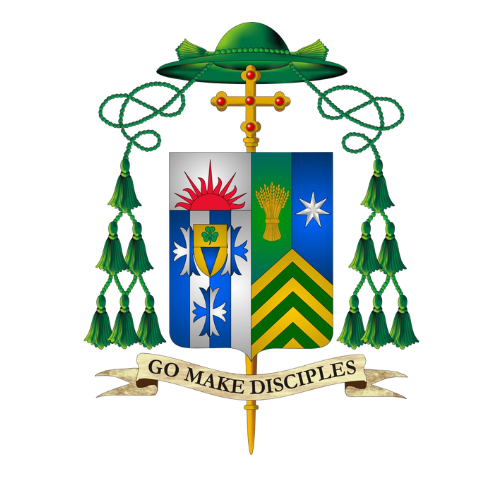Bishop Jeffrey M. Fleming

Coat of Arms of His Excellency, The Most Reverend Jeffrey Michael Fleming, Bishop of Great Falls-Billings

Motto
“Go Make Disciples”
For his episcopal motto, Bishop Fleming has chosen the beginning of the Great Commission that Jesus gives to the Church. By this choice, His Excellency wishes to express that all believers are called and commissioned by Christ to “Go Make Disciples.”
Blazonry of the Coat of Arms of
The Most Reverend Jeffrey Michael Fleming
As the local bishop of a diocese, heraldic tradition dictates that the Ordinary’s personal arms are to be joined (impaled) with the arms of his Diocese to symbolize that the Bishop is the personification of the Diocese. This “marriage” is additionally symbolized by the ring, which the Bishop wears.
Customarily the dexter impalement (left side of the shield) is given over to the arms of jurisdiction, in this case the Diocese of Great Falls-Billings. The Diocesan crest is composed of a main section that occupies the bottom two-thirds of the shield. This section of the shield is divided into four vertical sections, known as pales, of alternating blue and silver (white). These four sections are in the traditional heraldic colors of water and have straight edges to give the illusion of water falling rapidly from a great height and thus reflects the name of the prime See City of Great Falls. On these four pales are three crosses that are counter-changed, divided and colored opposite their background, to honor the Most Blessed Trinity. The upper one-third of the shield, known as a chief, is silver (white) on which is displayed a red demi-sun, to reflect the fact that the See City of Great Falls is located opposite the mouth of the Sun River. These have been the arms of the Diocese of Great Falls since it was erected on May 18, 1904.
In June of 1980, the Diocese of Great Falls became a dual See City diocese, now known as the Diocese of Great Falls-Billings, reflecting the growth of this region of Montana. To commemorate this change in the status of the diocese, an escutcheon, a small shield placed within the larger design, has been added to the former arms of the diocese. This smaller shield is divided into two halves, across the middle. The upper portion is gold (yellow) on which is placed a green trefoil, a three-petal flower, which is the heraldic representation of the shamrock, to honor Saint Patrick, titular of the Co-Cathedral in Billings. The lower portion is also gold and on this field is placed a blue pile; a “V”-shaped charge. If this section is looked at alone, the gold sides that are left by cutting out the blue pile, gives the illusion of the “rim-rocks”, the cliffs that surround the city of Billings.
For his personal arms, the sheaves of wheat are a typical Eucharistic symbol, and they also remind of the wide agricultural areas of Montana, rich with wheat fields, while the green underlines the color of the trees and pastures of this area.
The star symbolizes the Blessed Virgin Mary, our Celestial Mother, who lights the way of the Bishop.
In the point of the shield, we find three “chevronels” green (Vert); they recall the Rocky Mountains of the State of Montana.
Gold (Or), is the first among noble metals, it symbolizes the first virtue, faith.
the blue (Azure) color symbolizes separation from worldly values and the ascent of the soul toward God, therefore the run of the Celestial Virtues which raise themselves from the things of the earth toward heaven.
In accordance with the Roman Catholic Church’s heraldic tradition, the Coat of Arms of a Bishop is normally composed of:
- A shield with its charges(symbols) representing family, geographic, religious and historical meanings and/or referred to the name of the Bishop;
- A golden processional cross, with one traversal bar, to represent the rank of the Bishop, “impaled” behind the shield;
- A green hat (galero) with 12 attached tassels, graded 1; 2; 3; from the top;
- A scroll with the motto, printed in black, located beneath the shield.
Bishop Fleming has chosen a gothic shape shield, frequently used in Roman Catholic Church heraldry and a processional botonny cross with five red stones to represent the Five Wounds of Christ.
